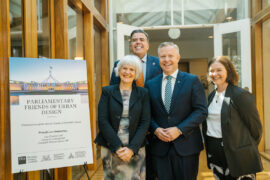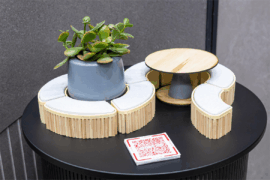Registered architects from Australia, the USA and New Zealand will be able to work internationally more easily following the signing of a significant trilateral agreement.

August 26th, 2024
Leaders of the Architects Accreditation Council of Australia (AACA), USA National Council of Architect Registration Boards (NCARB) and New Zealand Registered Architects Board (NZRAB) have agreed on a new Mutual Recognition Agreement at an event in Wellington, New Zealand.
AACA President, Dr Giorgio Marfella, said the agreement would benefit architects from all three nations by simplifying the qualifications needed for international practice and fostering mutual collaboration and opportunities within the profession.
“The Australian architectural profession is highly integrated on a global scale and shares a long tradition of affinity with New Zealand and the US,” he commented. “This new agreement further strengthens opportunities for sharing know-how and creativity, providing easier processes of exchange and recognition for architects at all levels of experience.”
The new agreement builds on an existing Mutual Recognition Agreement with the United States. However, there are additional benefits, such as the removal of a requirement to hold one of the three national passports, expanded eligibility qualifications, and streamlined data laws. Together, these changes are expected to boost the number of participating US states that participate in the new agreement.
Importantly, the current requirement to work 6000 hours following registration will be removed, allowing a newly registered architect in either country to apply. In Australia, New Zealand and most US states there are no additional tests or examinations following successfully completing the Mutual Recognition Agreement, however some US states may have additional requirements.
Registered architects from the three countries can apply for fast-tracked cross-border recognition of their qualifications from 6th November.
NCARB President Ken Van Tine said the new agreement would provide more opportunities, more efficiently, between the three nations: “The new agreement marks a significant step forward in international practice. By streamlining the reciprocity process, we’re empowering architects from different backgrounds to bring their expertise to a global market, while maintaining the high standards required for competent practice in order to protect the public.”
AACA Chief Executive Officer Kathlyn Loseby said the removal of the 6000-hour work rule, approximately three years, reflected a commitment to supporting international mobility: “Our mutual recognition programs are helping local architects to go global. We’ve already seen the success of our United Kingdom agreement, with more architects moving both ways across borders. This new agreement will make sure our high standards are maintained but also reduce the paperwork burden for individuals.”
There are mutual recognition agreements in place between Australia and the United Kingdom, Singapore, Japan, Canada, and New Zealand.
INDESIGN is on instagram
Follow @indesignlive
A searchable and comprehensive guide for specifying leading products and their suppliers
Keep up to date with the latest and greatest from our industry BFF's!

CDK Stone’s Natasha Stengos takes us through its Alexandria Selection Centre, where stone choice becomes a sensory experience – from curated spaces, crafted details and a colour-organised selection floor.

Rising above the new Sydney Metro Gadigal Station on Pitt Street, Investa’s Parkline Place is redefining the office property aesthetic.

The Parliamentary Friends reconvened at Parliament House, uniting political and professional leaders to champion architecture and design.

From the spark of an idea on the page to the launch of new pieces in a showroom is a journey every aspiring industrial and furnishing designer imagines making.
The internet never sleeps! Here's the stuff you might have missed

Gray Puksand’s adaptive reuse of former Melbourne office into Hester Hornbrook Academy’s new City Campus shows how architecture can support wellbeing, connection and community.

In contemporary interiors, ensuring a sense of comfort and wellbeing means designing and specifying finishes and products that support all the senses.